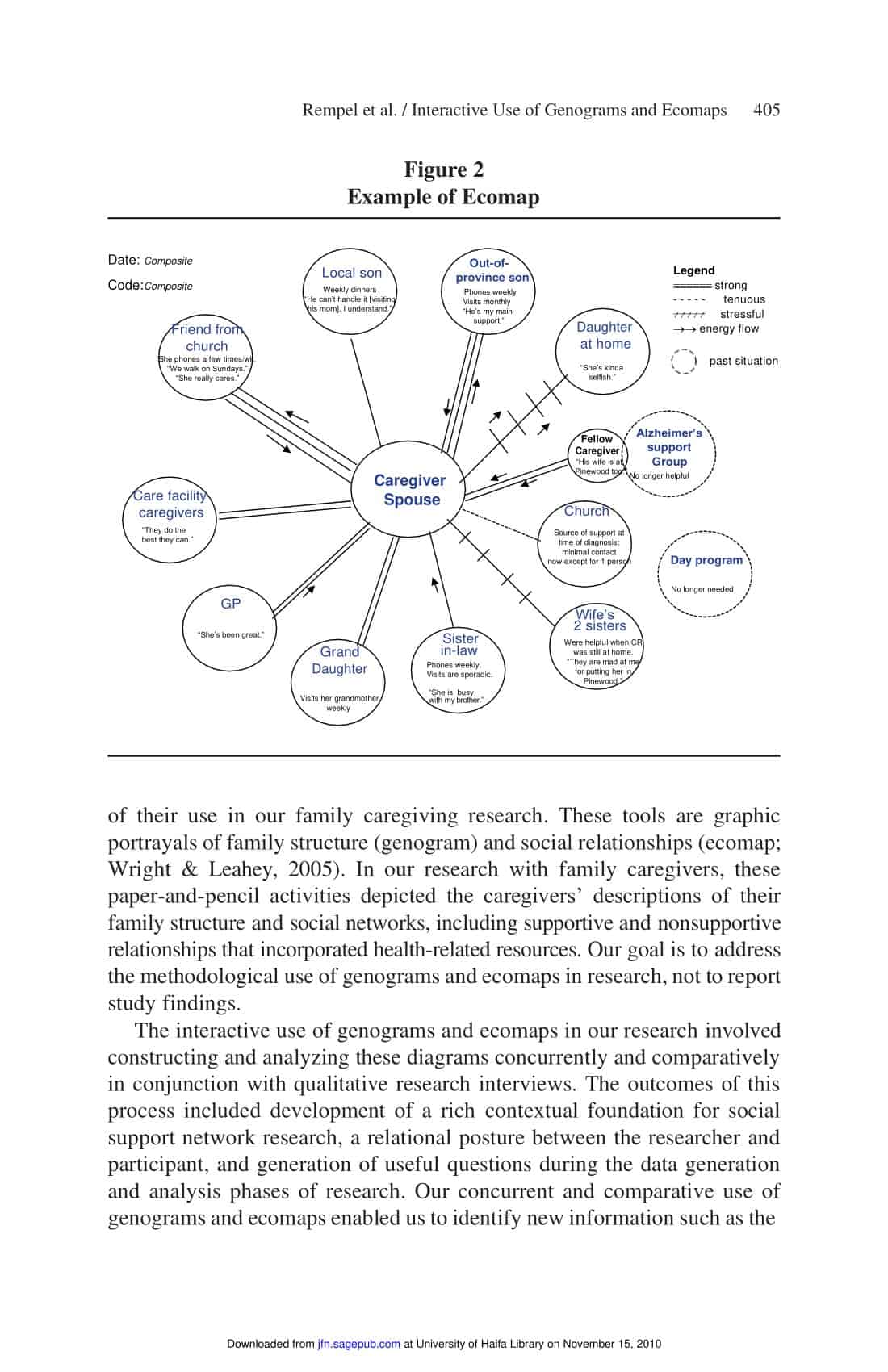Social workers, are you looking for a powerful tool to understand your clients’ complex lives? Ecomaps are visual representations of a client’s social ecosystem, revealing a wealth of information about their relationships, resources, and challenges. This comprehensive guide will equip you with the knowledge and skills to effectively utilize ecomaps in your practice, empowering you to make a real difference in the lives of your clients.
Understanding the Power of Ecomaps
Ecomaps, sometimes referred to as relationship maps or social network maps, offer a unique perspective on a client’s world. They go beyond simply listing relationships; they visually depict the quality and nature of these connections, highlighting both strengths and stressors. This holistic view allows social workers to see the “bigger picture” and work collaboratively with clients to create positive change. Think of an ecomap as a snapshot of a client’s social environment, offering valuable insights into their support network and the resources available to them. If you have lice and you’re wondering if you can use Lysol to kill them, you’ll want to read more here. And if you need a letter for your child’s Elf on the Shelf, be sure to check this out.
What is an Ecomap?
An ecomap typically consists of a circle in the center representing the client, surrounded by other circles representing different aspects of their life. Connecting lines illustrate the nature of these relationships, with variations in thickness and style indicating the strength, quality (positive, stressful, or tenuous), and direction of influence. For example, a solid line might depict a strong, supportive relationship, while a jagged line might represent a conflictual one. Arrows can further illustrate the flow of resources and energy between the client and the connected systems.
Building Ecomaps: A Collaborative Approach
Creating an ecomap is a collaborative process between the social worker and the client. It’s a conversation, not a dictation. The client is the expert on their own life, and their active participation is crucial. This collaboration builds trust and rapport, empowering clients to take ownership of their situation and actively participate in finding solutions.
Key Questions for Ecomap Development:
The questions used during the ecomap creation process can be tailored to the client’s age and situation. Here are some examples:
For Adults:
- “Who are the key people in your life?”
- “Who do you spend the most time with?”
- “Who would you talk to first in a crisis?”
- “Which relationships provide you with the most support?”
- “Are there any relationships that cause you stress or conflict?”
- “What community resources or organizations do you utilize?”
For Children:
- “Who do you live with?”
- “Do you have siblings?”
- “Who takes care of you at home?”
- “Tell me about your friends and school.”
- “Are there any adults you feel comfortable talking to?”
- “What activities do you enjoy doing in your free time?”
Visualizing Connections and Resources
The ecomap provides a visual representation of the client’s social connections and the resources available to them. This includes:
- Formal Systems: Healthcare providers, schools, therapists, social service agencies.
- Informal Systems: Family members, friends, neighbors, faith-based communities, support groups.
By mapping these connections, social workers can gain a comprehensive understanding of the client’s support network and identify potential areas where resources may be lacking or underutilized.
Using Ecomaps for Assessment and Intervention
Ecomaps are dynamic tools that can be used for both assessment and intervention planning. They offer a holistic view of the client’s life, enabling social workers to:
- Identify Strengths and Challenges: Ecomaps highlight both positive and negative relationships, revealing potential strengths that can be leveraged and areas where intervention may be needed.
- Develop Targeted Interventions: The insights gained from an ecomap can inform the development of targeted interventions, such as connecting the client with relevant community resources, facilitating family counseling, or providing individual therapy.
- Monitor Progress: Ecomaps can be revisited and updated over time, allowing social workers and clients to track progress and make adjustments to interventions as needed. This flexibility makes them a valuable tool for ongoing assessment and support.
Benefits of Ecomaps in Social Work Practice
Ecomaps offer a multitude of benefits in social work practice:
- Holistic Perspective: They consider the interplay of various factors influencing the client’s life, moving beyond a narrow focus on presenting problems.
- Client-Centered Approach: The collaborative nature of ecomap creation empowers clients and promotes a sense of ownership in the helping process.
- Enhanced Communication: Ecomaps serve as a visual aid, facilitating communication and understanding between the client, social worker, and other stakeholders.
- Strength-Based Focus: They highlight existing strengths and resources, promoting resilience and empowering clients to build on their assets.
- Targeted Interventions: Ecomaps enable social workers to develop interventions that are tailored to the client’s unique social context.
Ecomaps in Different Social Work Settings
The versatility of ecomaps allows them to be adapted to various social work settings and client populations.
- Child Welfare: Ecomaps can help understand complex family dynamics, identify potential risks to child well-being, and pinpoint areas where support is needed.
- Mental Health: They can illuminate the factors contributing to a client’s mental health challenges, including stressors, supports, and coping mechanisms.
- Community Development: Ecomaps can be used to map social networks within a community, identifying potential partnerships and resources for addressing collective issues.
- Geriatric Social Work: Ecomaps can help assess the support systems of older adults, identify potential risks for isolation or neglect, and facilitate access to necessary services.
The Future of Ecomaps: Ongoing Research and Development
While the core principles of ecomaps remain constant, the field continues to explore how to refine and enhance their application. Current research suggests that:
- Incorporating Qualitative Data: Adding qualitative data, such as the client’s subjective experience of their relationships, may offer richer insights.
- Leveraging Technology: Digital ecomap tools can streamline the creation and management process, facilitate data sharing, and potentially incorporate data analytics for identifying patterns and trends.
- Integration with Other Tools: Combining ecomaps with other assessment tools, such as genograms (family history diagrams), may provide a more comprehensive understanding of the client’s situation. It’s important to differentiate the two. Genograms focus on internal family relationships across generations, while ecomaps focus on current external social networks. Learn more about the differences between genograms and ecomaps.
Limitations and Ethical Considerations
While ecomaps are powerful tools, it’s essential to recognize their limitations and address ethical considerations:
- Subjectivity: The interpretation of ecomaps can be subjective, and it’s important to avoid making assumptions or imposing biases.
- Confidentiality: Maintaining client confidentiality is paramount. Ecomaps should be stored securely and only shared with authorized individuals.
- Cultural Sensitivity: Cultural factors can influence the interpretation of relationships and resources. Social workers should be mindful of these influences and adapt their approach accordingly.
Conclusion: Empowering Clients Through Connection
Ecomaps provide social workers with a valuable framework for understanding the complex interplay of factors influencing a client’s life. By visualizing the client’s social ecosystem, identifying strengths and challenges, and fostering collaborative problem-solving, ecomaps empower both clients and social workers to create meaningful and lasting change. While ongoing research continues to explore the nuances of ecomap interpretation and application, their core value lies in their ability to illuminate the power of human connection and promote client well-being.
- Unlock 6000+ words beginning with he: A comprehensive analysis - April 20, 2025
- Mastering -al Words: A Complete Guide - April 20, 2025
- Master Scrabble: High-Scoring BAR Words Now - April 20, 2025

















1 thought on “The Ultimate Guide to Ecomaps in Social Work: Templates, Examples, and Best Practices”
Comments are closed.